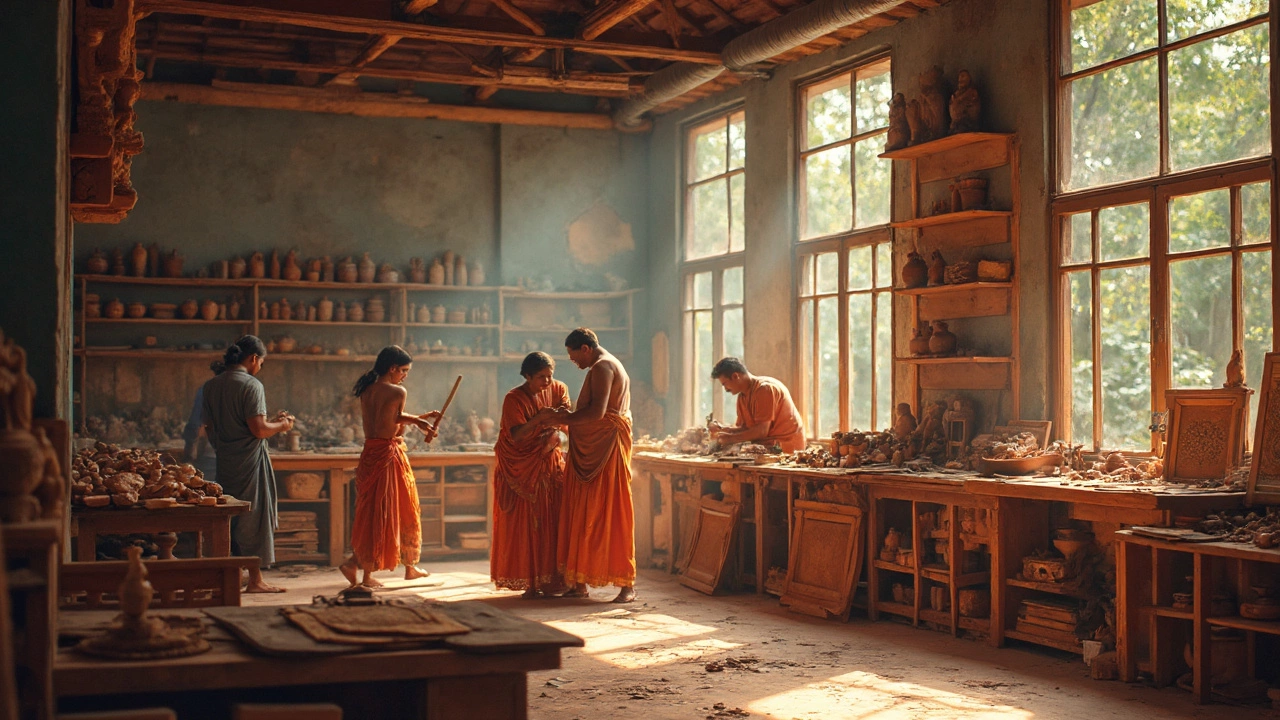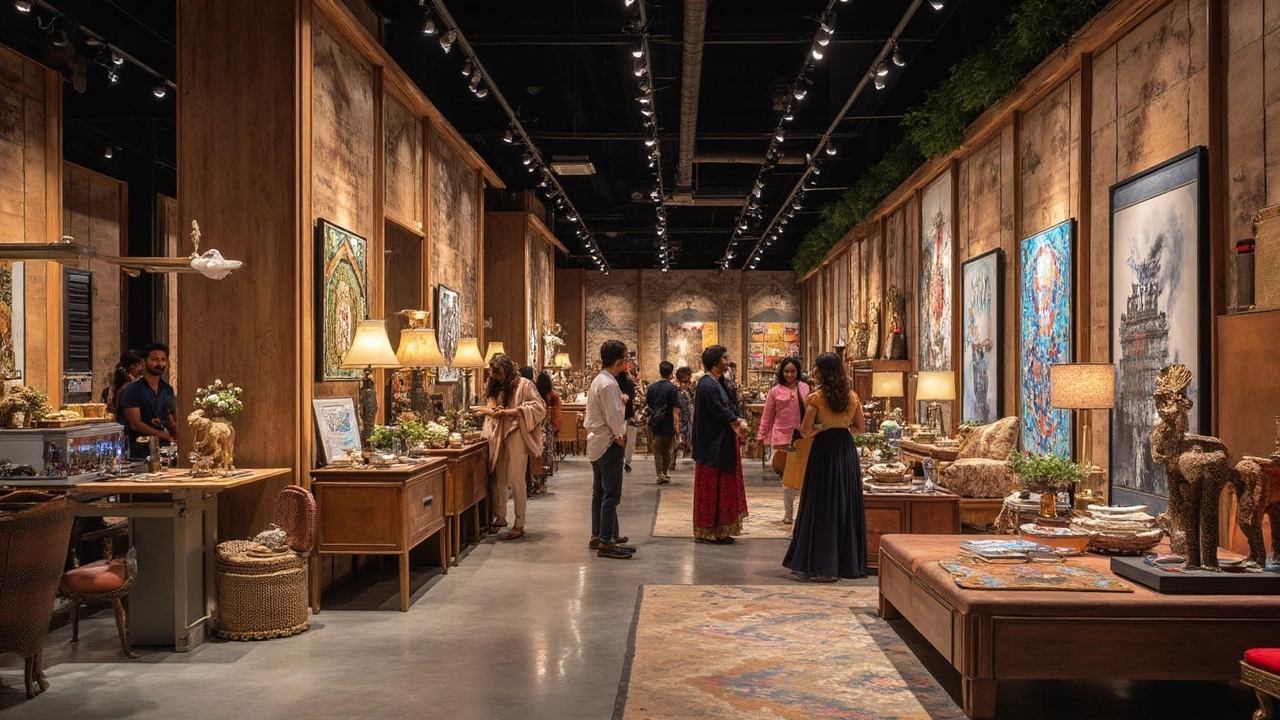 Feb, 22 2025
Feb, 22 2025
Ever wonder why India is fast becoming a big name in furniture manufacturing? Well, you're not alone. Thanks to a mix of age-old traditions and modern techniques, Indian furniture offers a unique blend that appeals to many.
The country's heritage is full of skilled artisans who have passed down their knowledge through generations. It's not just about making furniture; it's about making a statement with each piece. Whether you're looking at intricately carved wooden tables or sleek metal chairs, each item tells a story.
What's more, the rising stars in the Indian manufacturing industry aren't just sticking to the old ways. They're innovating, blending traditional skills with technology to meet new demands. It's this adaptability that puts India on the global map for furniture.
- India's Furniture Heritage
- Rising Stars in Indian Manufacturing
- Quality and Craftsmanship
- Sustainability and Materials
- Global Influence and Trade
India's Furniture Heritage
When we talk about Indian furniture, we're diving into centuries-old traditions and beautifully crafted pieces that reflect the country's vast diversity. From the intricate woodwork of the north to the vibrant colors of the south, India's furniture story is as diverse as its culture.
History and Craftsmanship
India's journey in furniture manufacturing goes back thousands of years. Ancient craftsmen were masters of wood carving, particularly in regions like Rajasthan and Gujarat, where ornate designs have always been a staple. You'll find that traditional methods, like hand-carving and inlay work, are still very much alive today, particularly in places like Jodhpur often called the 'Blue City', which houses some of India’s finest craftsmen.
Materials
When it comes to materials, Indian furniture often utilizes solid wood like teak and rosewood, which are prized for their durability and beauty. Techniques like metalwork and cane weaving also play a significant role and showcase the adaptability of Indian artisans.
The Influence of Diverse Cultures
India's furniture designs have been shaped by a myriad of cultural influences over the years. With the Mughal era, for example, came a fusion of Persian and Indian styles, leading to the creation of luxurious and monumental pieces that are still in demand today. Even today, you'll see Mughal influences in the form of arches and intricately crafted furniture.
In short, India’s furniture heritage is like a beautifully woven tapestry—rich, detailed, and full of stories. This history not only boosts the country’s reputation but also ensures that it remains a top player in the global furniture market.
Rising Stars in Indian Manufacturing
India's furniture scene is lighting up with new talent and fresh ideas. Who are these rising stars? Young companies and innovative startups are leading the charge, transforming the landscape with creativity and efficiency.
Meet the Innovators
Take Urban Ladder, for instance. Founded in 2012, they've quickly become a household name. They blend contemporary designs with traditional craftsmanship, offering a wide range of home furnishings that fit modern lifestyles. Consumers love their online-first approach, which makes shopping easy and accessible.
Another standout is Pepperfry. Launched in 2011, this brand focuses on offering diverse furniture options across various styles and budgets, reaching customers far and wide. Their showrooms and online presence make them versatile in an ever-competitive market.
Where Tradition Meets Technology
India's furniture manufacturers are not leaving tradition behind, though. Many companies still rely on local artisans for exceptional quality. Yet, they're integrating technology like never before.
- 3D Printing: Some businesses use 3D printing for custom furniture design, improving accuracy and reducing costs.
- Sustainable Practices: Embracing eco-friendly materials, these manufacturers respond to the growing demand for green products.
- AI and Big Data: Automation helps in inventory management, ensuring consumers get what they want faster.
These innovations are what set rising companies apart. They cater to global tastes while maintaining the rich history and crafts of India.
A Peek into the Numbers
| Company | Year Founded | Specialty |
|---|---|---|
| Urban Ladder | 2012 | Contemporary Designs |
| Pepperfry | 2011 | Diverse Styles and Budgets |
With competition heating up, these companies aren't just sitting pretty; they are adapting to new challenges and opportunities. That’s how India's furniture market is growing stronger, making a notable impact on the global stage.

Quality and Craftsmanship
When it comes to Indian furniture, quality and craftsmanship go hand in hand. You might wonder how these pieces end up being so iconic. It all starts with skilled artisans who have honed their craft over generations.
Unlike mass-produced furniture, many pieces from India are made with hands that know the art of storytelling through wood and metal. This focus on detail means that even the simplest items have a unique touch, often featuring intricate carvings or bespoke finishes that can't be replicated by machines.
The Role of Materials
Materials play a massive role in the quality of Indian furniture. High-quality wood like teak, rosewood, and mango are not only popular in India but also admired worldwide for their durability and aesthetic appeal. These materials are chosen not just for looks, but for their ability to withstand the test of time.
Artisans in Action
The artisans behind these creations aren't just laborers; they're artists. Imagine walking into a workshop in Jodhpur or Jaipur and observing a craftsman chiseling away with an attention to detail that's almost meditative. The result? Furniture that isn't just functional but also a piece of art.
The use of vibrant colors and traditional motifs, often inspired by ancient Indian culture, makes each item a conversation starter. It's no wonder that those seeking unique and personalized pieces often turn to India for their furniture needs.
Advantages and Challenges
While the craftsmanship is unmatched, it’s also important to face some challenges head-on. Access to international markets can sometimes be tricky due to logistics, but advancements in trade regulations are helping bridge these gaps.
| Material | Durability (Years) |
|---|---|
| Teak | 20+ |
| Rosewood | 25+ |
| Mango | 15+ |
So if you're on the lookout for something special, understanding the quality and craftsmanship of Indian furniture is essential. The next time you sit on a beautifully carved chair or admire an intricately designed table, remember the skill and heart that went into making it.
Sustainability and Materials
When it comes to furniture manufacturers in India, sustainability isn't just a buzzword. It's becoming a central part of their production process. With the world becoming more conscious about environmental impact, the furniture industry is no exception.
Eco-Friendly Practices
Many Indian manufacturers are shifting towards greener methods, reducing waste, and opting for sustainable practices. This includes using renewable energy sources and recycling materials wherever possible. These efforts not only help the planet but also lead to innovative designs that consumers love.
Material Choices
Indian furniture is known for its use of natural materials. Wood remains a favorite, with teak, rosewood, and mango wood being top picks. These woods are not only durable but also add a touch of elegance to any piece.
Metals like iron and brass are also used creatively, especially in urban designs. By combining these materials with traditional methods, manufacturers create something that's both new and timeless.
The Role of Certification
Consumers today are interested in the origin of products. Indian manufacturers are stepping up by seeking certifications that guarantee their products meet global environmental standards. This is not just a boost for their own credibility, but it also strengthens India's position on the global stage.
| Material | Carbon Footprint |
|---|---|
| Teak | Low |
| Iron | Moderate |
By choosing sustainably sourced materials and practices, Indian companies show the world that responsible manufacturing is the way forward. Whether you're in the market for a new dining set or a stylish bed frame, knowing you're supporting eco-friendly practices makes the purchase all the more rewarding.

Global Influence and Trade
India’s furniture industry isn't just about local markets anymore; it’s playing a major role on the world stage. With a combination of rich cultural heritage and modern manufacturing techniques, India stands out in the global marketplace for furniture.
One thing that makes India a leader is its ability to produce quality furniture at competitive prices. This attracts buyers from all over—whether it's a small craft boutique in Australia or a massive retailer in Europe. Why? Because when customers see Indian furniture, they know they’re getting more than just utility. They’re buying a piece of artistry.
Expanding Markets
Countries like the USA, UK, and Germany are some of the biggest importers of Indian furniture. In fact, exports have been climbing steadily in recent years due to increased demand for products that combine style with sustainability. The use of eco-friendly materials like reclaimed wood has further boosted this demand.
Additionally, many furniture manufacturers in India have embraced online platforms to reach international customers. This digital presence means you can easily find Indian pieces on popular ecommerce sites, making them accessible to a global audience.
Trade Partnerships
India has also been proactive in establishing trade agreements with other countries to facilitate smooth exports. Partnerships with Southeast Asian countries have eased the flow of goods, shedding light on India's dedication to boosting its global influence.
Have you ever thought about why Indian furniture is popping up in your local stores? It's not a fluke—it’s a strategic effort by manufacturers to build their brands beyond borders.